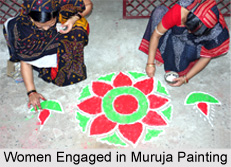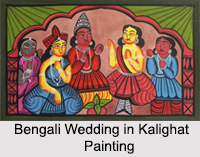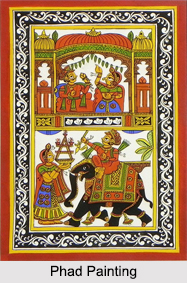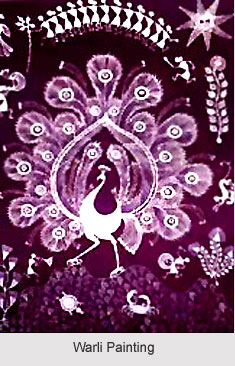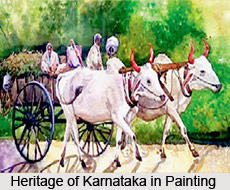 Karnataka paintings follow a long line of development. The earliest paintings in Karnataka can be traced back to the megalithic people who occupied Karnataka in the 1st millennium B.C. There handiworks are mostly in the form of primitive paintings which were made on the walls of caves etc. They mostly depicted the animal life of the region. From the megalithic times, the advancement of painting was seen on pottery and other articles, murals on caves, on temples, on the walls of mansions and palaces and on paper. Etchings from the time of Emperor Ashoka can be seen in rock boulders in the region, which gives inkling into the life of the people at the time.
Karnataka paintings follow a long line of development. The earliest paintings in Karnataka can be traced back to the megalithic people who occupied Karnataka in the 1st millennium B.C. There handiworks are mostly in the form of primitive paintings which were made on the walls of caves etc. They mostly depicted the animal life of the region. From the megalithic times, the advancement of painting was seen on pottery and other articles, murals on caves, on temples, on the walls of mansions and palaces and on paper. Etchings from the time of Emperor Ashoka can be seen in rock boulders in the region, which gives inkling into the life of the people at the time.
The earliest murals found in Karnataka are seen at Badami. These were made in the 6th century under the Chalukya kings who held sway over the region. Early Buddhist influences can be seen rather strongly in these paintings. The Rashtrakutas who followed them continued the patronage towards painting and the other arts. The Ajanta caves, the earliest examples of murals in India, became the centre for religious and cultural interest. However, there seems to be a sudden lull in the painting scenario. The continuity that is seen in the field of art and architecture is lost in the case of Karnataka paintings. After the solitary instance of the Badami murals, the next big works are seen in the Vijayanagara period (1336-1665 AD), and that too in the 15th-16th centuries. Thus after a gap of almost 3 to 4 centuries, a few murals are to be seen. However, based on the extensive paintings found throughout the region, belonging to different points in time, the various Karnataka paintings can be more comprehensively studied by dwelling on their style, type and influences.
Types of Karnataka Paintings
Broadly speaking, the Karnataka paintings can be classified into three main types. These are murals, illustrated manuscripts and miniatures.
Murals are paintings which have been done on caves and on the ceilings and walls of temples, palaces and mansions. The most well known murals in Karnataka paintings are the Badami murals which were made during the rule of the Chalukya dynasty. The most outstanding example of cave murals can be seen at Ellora caves, which display paintings from all three religions. Temple murals in Karnataka can be seen at the Lepakshi temple built during Vijayanagara times. They are found on the high ceiling of the huge gateway, the vimana, of the Virupakshi temple. As regards the paintings on the walls and ceilings of palaces and mansions, Athani, Nippana and Nargund contain some excellent examples of the same.
Illustrated Manuscripts include paintings done on handy materials, like palm leaf, wood panels, cloth, paper etc. Since all these are quite old and can be easily transferred, they are also easily destroyed. In Karnataka, the earliest manuscripts were written on palm leaf. Since they deteriorated easily, palm leaf manuscripts older than 3 centuries are rather rare. The use of hand-made paper for books began with the Muslim advent in the Deccan. This style was mostly favoured by the rulers of Bijapur and Ahmednagar. However, this activity remained confined to the royal courts and the use of palm leaf continued among the common people. Though manuscripts do not usually contain illustrations, the Dhavala manuscripts at Mudabidri have remarkable illustrations on them. The manuscripts make up three texts, and two out of three contain beautiful coloured illustrations.
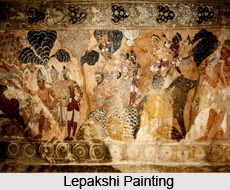 Most of the miniatures in Karnataka paintings are of the Muslim rulers of Bijapur. A distinct style of painting developed when Karnataka paintings came into contact with the Mughal influence. Thus most of the miniatures were produced during the rule of the Adil Shahi dynasty of Bijapur, up towards the northern part of Karnataka.
Most of the miniatures in Karnataka paintings are of the Muslim rulers of Bijapur. A distinct style of painting developed when Karnataka paintings came into contact with the Mughal influence. Thus most of the miniatures were produced during the rule of the Adil Shahi dynasty of Bijapur, up towards the northern part of Karnataka.
Style of Karnataka Paintings
Karnataka paintings show a great variety in style. However, this does not indicate that one particular kind of style was found at one particular point in time, as the time frames for the different painting style can be found to overlap. Based on a general view, three main painting styles emerge in the Karnataka paintings. These can be better understood with reference to the most outstanding piece of work made in that particular style.
Deccani School of Painting emerged in the Adil Shahi period. It developed during the Mughal era, and has adopted quite a bit from the Mughal style though it is not similar to it. This genre of paintings mostly deals with miniatures, portraits and even to some extent illustrations produced during the Adil Shahi period. The artists of the Deccani paintings displayed warm colours and a fine sense of line and composition. This is more sophisticated than the normal folk art, and remarkable self-restraint can be seen in the paintings. They drew inspiration from Amir Khusru`s book of poems which has excellent illustrations in the Persian style. The common topics that these portraits dealt with were to do with religion which included the paintings of Gods and goddesses like Saraswati and Lakshmi, paintings of ragas and raginis due to the patronage given to the arts, and a number of paintings were portraits of famous court personalities of the time.
Lepakshi paintings comprise one of the most significant murals in Karnataka paintings. This temple was constructed in the 16th century during the Vijayanagara period. The murals are seen on the high ceiling of the huge gateway of the Veerabhadra temple. Most of the murals here deal with figures and themes from mythology. Most of the panels here depict the Hindu Gods- Lord Shiva, Lord Vishnu etc. Mythological characters like Arjuna can also be seen here. Some of the murals have been dedicated to unknown figures. The preferred style seems to have been painting in profile which is abundantly seen here. The profile figures are shown tilting backwards, from the feet upwards till the waist, and then again forward from the waist to the neck. The head stands erect. Great detailing has been put into the costumes and ornaments of the various figures. The panels are bordered with decorative margins on four sides, which go very well with the central panel. The background has been made in a light shade which better captures the figures in front. The line work is not continuous, and sometimes some facial profiles may not have a line at all. In terms of both the brush work and the lines, the parts do not attain unity with the total figure.
Dhavala Manuscripts
This style of painting is seen in the Dhavala manuscripts, which are illustrated manuscripts dating back to over 750 years. The manuscripts are ancient Jain texts that have been divided into three books, and two out of these contain coloured illustrations. The illustrations occupy the right and left margins of the palm leaves, and the middle portion contains the text. The subject of the paintings is Jain tirthankaras, Munis, Yakshas and Yakshinis. On the right and left edges decorative borders have been painted. The fine line work delineates the various figures and the spaces within and without are worked in flat colours. Tempera colours have rarely been used and light shades are rarely used. The main features characteristics of the illustrations are fine craftsmanship and charming flat colours.
Religious Influence on Karnataka Paintings
It must be noted here that religion is a recurring theme in all the Karnataka paintings, irrespective of the time or style of its creation. The image of Lord Krishna as an unpredictable, adventurous child, and also his love life, has given enough material for depicting the lord in many moods. Depiction of Hindu Gods and Goddesses- Saraswati, Lakshmi, Lord Vishnu, Lord Shiva- is seen as a persistent theme in all of Karnataka paintings, even when the influence of Muslim rule was felt in the Deccani paintings. In the Lepakshi murals, the religious theme abounds. 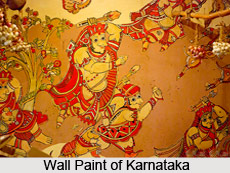 The murals consist of many mythological scenes, and there are numerous panels here which depict Lord Shiva and Parvati as Uma. Also seen here is Arjuna`s archery feat with Draupadi by his side even in the later paintings such as the mansions at Nippani, Athani and the Nargund palace, the religious themes continue.
The murals consist of many mythological scenes, and there are numerous panels here which depict Lord Shiva and Parvati as Uma. Also seen here is Arjuna`s archery feat with Draupadi by his side even in the later paintings such as the mansions at Nippani, Athani and the Nargund palace, the religious themes continue.
Karnataka paintings can thus be seen covering a broad spectrum in terms of era and style. Though there was the danger of losing this art form after the sudden lull following the Badami murals, the Lepakshi paintings once again ensured that Karnataka paintings shone forth in their full splendour. Despite the time of their existence and the influences exerted on them, Karnataka paintings have managed to keep their essence intact, and they are the remarkable legacies of majestic dynasties long gone from history.

